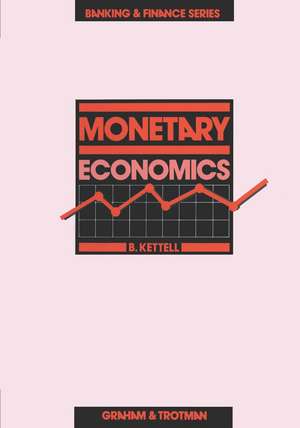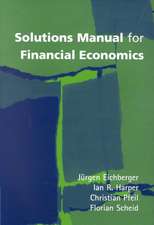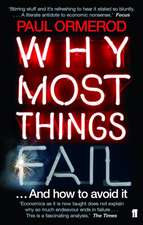Monetary Economics: Banking and Finance Series, cartea 1
Autor B. Kettellen Limba Engleză Paperback – 31 aug 1985
Preț: 399.12 lei
Nou
Puncte Express: 599
Preț estimativ în valută:
76.37€ • 79.74$ • 63.21£
76.37€ • 79.74$ • 63.21£
Carte tipărită la comandă
Livrare economică 05-19 aprilie
Preluare comenzi: 021 569.72.76
Specificații
ISBN-13: 9780860105626
ISBN-10: 0860105628
Pagini: 372
Ilustrații: 372 p.
Dimensiuni: 178 x 254 x 21 mm
Greutate: 0.68 kg
Ediția:Softcover reprint of the original 1st ed. 1985
Editura: SPRINGER NETHERLANDS
Colecția Springer
Seria Banking and Finance Series
Locul publicării:Dordrecht, Netherlands
ISBN-10: 0860105628
Pagini: 372
Ilustrații: 372 p.
Dimensiuni: 178 x 254 x 21 mm
Greutate: 0.68 kg
Ediția:Softcover reprint of the original 1st ed. 1985
Editura: SPRINGER NETHERLANDS
Colecția Springer
Seria Banking and Finance Series
Locul publicării:Dordrecht, Netherlands
Public țintă
ResearchCuprins
1 The Concept of Money.- Money — evolution and functions.- From paper money to bank deposits.- The cheque clearing system.- The characteristics of money.- Liquidity.- The quantity theory of money — the basis of monetarism.- The measurement of the money supply.- Domestic credit expansion.- A key issue in monetary theory.- Appendix 1.- 2 The United Kingdom Financial System.- The functions of a financial system.- The monetary sector.- The Bank of England.- Balance sheet management of the clearing banks.- Other financial institutions (OFIs).- The 1979 UK Banking Act — The background to the legislation.- The supervision and monitoring proposals — the post-banking Act position.- Appendix 1.- 3 Money Markets.- What is a money market?.- The London money market.- The discount market.- The parallel markets.- Money markets and the financial press.- Appendix 1.- 4 The Money Supply.- The bank credit multiplier.- Can the banks manufacture money indefinitely?.- The major influences on UK money supply changes.- The major controls influencing recent monetary growth.- Monetary control implications.- Can the authorities control the money supply?.- Appendix 1.- Appendix 2.- 5 Interest Rates.- Function of interest rates.- Determination of interest rates, demand and supply of funds.- International factors affecting interest rates.- The term structure of interest rates.- Default risk.- The role of inflation.- The determination of retail bank’s base rate.- Appendix 1.- 6 Aspects of Monetary Theory.- Monetarists and the quantity theory of money.- Keynes, money and inflation.- Macro-economic policy — is it necessary?.- The new classicists and the rational expectations school.- The Phillips curve and inflation.- The monetarists versus the Keynesian debate: its implications formonetary targets.- Fiscal policy.- The role of the exchange rate.- Monetarist and Keynesian views: some further considerations.- 7 Controlling Money Supply.- Criteria of efficiency in monetary control.- The goals of monetary policy.- The targets of monetary policy.- Exchange rate targets and monetary targets: the need for choice.- Intermediate indicators of monetary policy.- Instruments of monetary policy: market forces versus portfolio constraints.- Market operations: the techniques.- Portfolio constraints: the techniques.- The Public Sector Borrowing Requirement (PSBR).- Lags.- The efficiency of monetary control.- The medium-term financial strategy.- 8 International Trade and the Balance of Payments.- Why do countries trade?.- How has world trade evolved?.- What is the balance of payments and why is it important?.- The changing nature of UK trade and payments.- The adjustment problem.- Are import controls desirable?.- Appendix 1.- Appendix 2.- Appendix 3.- 9 The Foreign Exchange Market.- Exchange rate regimes.- The breakdown of the Bretton Woods system.- The impact of OPEC on the international economy.- Floating exchange rates and the new role of the IMF.- The European monetary system — the intervention systems.- Has the EMS been a success?.- Should Britain join the EMS.- Fixed versus flexible exchange rates.- Overshooting — an argument for fixed exchange rates.- Forecasting exchange rates.- Forecasting exchange rates by using one single variable.- 10 International Liquidity.- The International Monetary Fund.- Foreign exchange.- Central Bank gold holdings.- Special drawing rights.- How have international reserves grown over time?.- What characteristics should areserve asset possess.- The “privatisation” of the creation of new international liquidity.- 11 TheEuro-Currency Markets.- What are Eurocurrencies?.- Why do Eurocurrency markets exist?.- Structure of Eurocurrency interest rates.- The relationship between Eurocurrency interest rates and domestic interest rates.- The effects of controls on capital flows.- The relationship between Euromarkets and the foreign exchange market — the forward exchange market.- The Eurodollar credit multiplier.- Should the Eurocurrency markets be controlled?.- Appendix 1.- Appendix 2.- Further Reading.



















